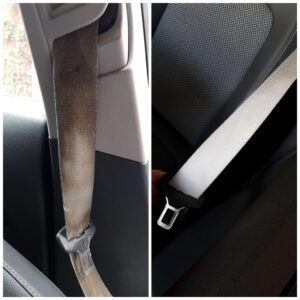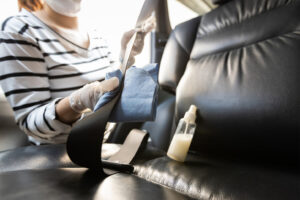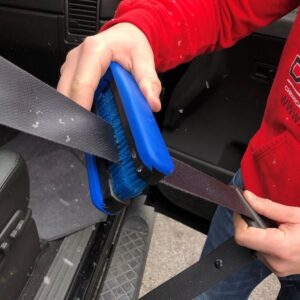Cleaning a seat belt buckle is important for maintaining the safety and functionality of your car’s seat belts. Here is a simple guide on how to clean your seat belt buckle.
How to clean your seat belt buckle
- Gather your supplies: You will need a soft cloth, warm water, and a mild soap or detergent.
- Remove any dirt or debris: Use the cloth to gently wipe away any dirt or debris from the surface of the buckle. Be sure to pay attention to the corners and crevices, as dirt can accumulate in these areas.
- Create a soapy solution: In a small bowl or cup, mix a small amount of mild soap or detergent with warm water. Stir to create a soapy solution.
- Wipe down the buckle: Dip the cloth into the soapy solution and use it to wipe down the entire surface of the buckle. Be sure to get into all of the nooks and crannies.
- Rinse the buckle: Rinse the buckle thoroughly with warm water to remove any soap residue.
- Dry the buckle: Use a dry cloth to pat the buckle dry. Be sure to dry it thoroughly to prevent rusting.
- Test the buckle: Once the buckle is dry, test it to make sure it is functioning properly.
By following these steps, you can easily clean your seat belt buckle and ensure that it is in good working order. It is important to regularly clean your seat belt buckle to maintain the safety of your car’s seat belts.
Can car seat belts be washed?
Car seat belts are an essential safety feature in any vehicle. They help to keep drivers and passengers secure in the event of a collision or sudden stop, reducing the risk of serious injury. However, over time, seat belts can become dirty or soiled from spills, food, or other substances. This can not only be unsightly, but it can also make the seat belts less effective at keeping you safe.
So, can car seat belts be washed? The short answer is yes, but it’s important to follow certain guidelines to ensure that they are washed safely and properly.
First, it’s important to check the owner’s manual for your vehicle to see if the manufacturer has any specific recommendations for cleaning seat belts. Some seat belts may have special coatings or materials that could be damaged by certain cleaning products or methods.
If there are no specific recommendations in the owner’s manual, you can generally clean seat belts using a mild detergent and a damp cloth. Avoid using harsh chemicals or abrasive cleaners, as these can damage the seat belts or strip away any protective coatings.
To clean the seat belts, start by wiping them down with a damp cloth to remove any loose dirt or debris. Then, mix a small amount of mild detergent with warm water and use a clean cloth to gently scrub the seat belts. Be sure to pay special attention to any areas that are particularly soiled or stained.
Once you’ve scrubbed the seat belts, use a clean, damp cloth to wipe away any soap or dirt. Finally, use a dry cloth to blot the seat belts to remove any remaining moisture.
It’s also a good idea to regularly inspect your seat belts for any signs of wear or damage. If you notice any fraying, tears, or other damage, it’s important to have the seat belts repaired or replaced as soon as possible.
In summary, car seat belts can be washed, but it’s important to use a mild detergent and a gentle cleaning method to avoid damaging the belts. Be sure to follow the manufacturer’s recommendations, if available, and regularly inspect the seat belts for any signs of wear or damage.
What can I use to clean seatbelts?
Keeping your seat belts clean is not only important for maintaining the appearance of your vehicle, but it can also help to ensure that they are functioning properly. If you’re wondering what you can use to clean seat belts, there are a few options to consider.
The first step in cleaning seat belts is to check the owner’s manual for your vehicle to see if the manufacturer has any specific recommendations for cleaning the belts. Some seat belts may have special coatings or materials that could be damaged by certain cleaning products or methods, so it’s important to follow any guidelines provided by the manufacturer.
If there are no specific recommendations in the owner’s manual, you can generally clean seat belts using a mild detergent and a damp cloth. Avoid using harsh chemicals or abrasive cleaners, as these can damage the seat belts or strip away any protective coatings. If the seatbelt is particularly bad, try using a steamer to remove stubborn stains.
To clean the seat belts, start by wiping them down with a damp cloth to remove any loose dirt or debris. Then, mix a small amount of mild detergent with warm water and use a clean cloth to gently scrub the seat belts. Be sure to pay special attention to any areas that are particularly soiled or stained.
Once you’ve scrubbed the seat belts, use a clean, damp cloth to wipe away any soap or dirt. Finally, use a dry cloth to blot the seat belts to remove any remaining moisture.
If you prefer to use a commercial cleaner to clean your seat belts, there are several products on the market specifically designed for this purpose. Look for a cleaner that is safe for use on automotive upholstery and that is free from harsh chemicals or abrasives. Follow the instructions on the product label, and be sure to test it on a small, inconspicuous area of the seat belts before applying it to the entire surface.
In summary, seat belts can be cleaned using a mild detergent and a damp cloth, or with a commercial cleaner specifically designed for use on automotive upholstery.
Can I use bleach on seatbelts?
Bleach is a powerful cleaning agent that is often used to kill bacteria and remove stains from a variety of surfaces. However, when it comes to cleaning seat belts, it’s generally not a good idea to use bleach. Here’s why: while bleach may be effective at killing bacteria and removing stains, it is also a harsh chemical that can damage or discolor the seat belts.
In addition to potentially damaging the seat belts, using bleach on seat belts can also be a safety hazard. When bleach comes into contact with certain materials, it can release chlorine gas, which can be toxic if inhaled. This is especially a concern if the seat belts are installed in a vehicle that is used by children or pets, as they may be more vulnerable to the effects of chlorine gas.
If you need to clean your seat belts and want to avoid using bleach, there are several other options to consider. A mild detergent and a damp cloth can be effective at removing dirt and stains from seat belts, or you can use a commercial cleaner specifically designed for use on automotive upholstery as described above. Be sure to follow the instructions on the product label, and test it on a small, inconspicuous area of the seat belts before applying it to the entire surface.



